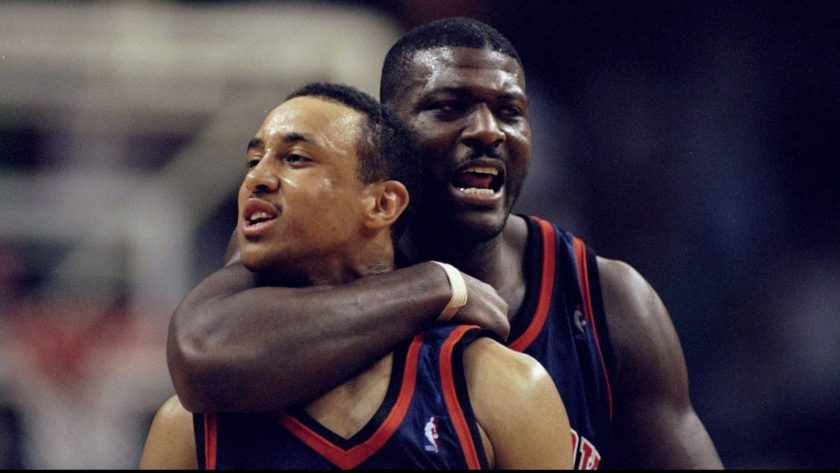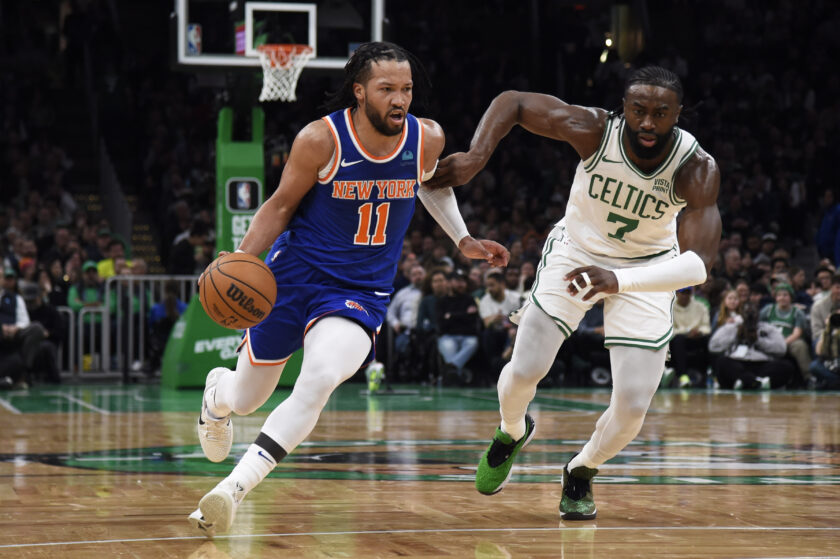New York Knicks: Drafting the all-1990s team

The 1990s was the last golden age of New York Knicks basketball, but who best defines the teams from that decade?
[sc name=”josh-benjamin-banner” ]The 1990s were a great time to be a New York Knicks fan.
Patrick Ewing’s dominance continued as he matured as a player. The front office, led by general manager Ernie Grunfeld, built around the star big man accordingly. Slowly but surely, the Knicks started looking like a viable championship contender. Had it not been for Michael Jordan and those pesky Chicago Bulls, perhaps New York would have made more than just the 1994 NBA Finals.
And despite the lack of titles, the 1990s were the best era of New York Knicks basketball since the 1970s. The front office drafted well. The coaching carousel was eventually turned off. New York had a starting lineup and overall roster that provided hope for the future beyond Ewing and the core around him.
History panned out differently and now, every Knicks fan looks back on the ’90s teams with nostalgia. As Archie and Edith Bunker always said, those were the days.
Thus, with the NBA resuming practices in the near future, let’s build the Knicks’ ultimate ’90s team.
Honorable Mention: Anthony Mason (Knicks tenure: 1991-1996)
https://www.youtube.com/watch?v=4BZDS-OPobg
It’s impossible to look back at the New York Knicks of the 1990s and not mention Anthony Mason. The former third-round pick was built like a tank at a squat 6-foot-7, 250 pounds. After being waived by the Denver Nuggets, he signed with New York as a free agent in 1991.
The Queens native then left his mark in the Big Apple, and how. Mason spent the next five years mostly coming off the Knicks’ bench and giving opposing players fits with his defense. In the 1995-96 season, his first as a full-time starter, he led the NBA in minutes per game.
Mason averaged 9.9 points and 7.7 rebounds per game in his five New York seasons and was named Sixth Man of the Year in 1995. Unfortunately, because the Knicks were so good in the ’90s, someone has to get an honorable mention. Given Mason’s knack for being a burst off the bench, it seems fitting he be the one.
PG: Charlie Ward (Knicks tenure: 1994-2004)

Charlie Ward is one of the more interesting players in New York Knicks history. The team made him a first-round pick in 1994, but Ward was known more for non-basketball reasons. Despite being selected in the NBA Draft, Ward was actually the reigning Heisman Trophy winner the previous year and quarterbacked Florida State to a national championship.
Deemed too small for the NFL, the 6-foot-2, 190-pound Ward made his fortune in the NBA, and how. It took a few years, but Ward soon established himself as an excellent pest. He led the league in defensive box plus/minus (DBPM) in 1998 and posted a respectable career mark of 2.2 as a Knick. Ward could also be a threat from long range, making 36.6% of his threes in a New York uniform.
Ward was never an elite scorer, and was eventually traded to the Phoenix Suns in the Stephon Marbury trade. Still, if there was any ’90s point guard who fit well into the New York Knicks’ tough defensive system, it was him.
SG: John Starks (Knicks tenure: 1990-1998)

Every New York Knicks fan has something to say about John Starks. What if he hadn’t gone cold in Game 7 of the 1994 Finals? Why can’t anyone turn away from him dunking on both Michael Jordan and Horace Grant in the 1993 Eastern Conference Semifinals?
Simply put, Starks was a force. He was smaller at 6-foot-3, 180 pounds, but played bigger, and with a huge chip on his shoulder. The undrafted sensation spent most of his New York tenure bouncing between the starting lineup and bench. Despite that, he held his own in the scoring department and averaged 14.1 points per game as a Knick. Starks was also the 1997 Sixth Man of the Year.
But more importantly, Starks was effective in New York. Not necessarily elite, mind you, but he posted a 16.7 VORP wearing the orange and blue. If we convert that into baseball’s equivalent, wins-above replacement (WAR), he posts a mark of 45.1 over eight years. That’s an average of 5.63 wins per year.
Needless to say, when Starks was sent to the Golden State Warriors in the Latrell Sprewell trade, more than a few Knicks fans wept.
SF: Larry Johnson (1996-2001)

Larry Johnson’s NBA tenure is a tale of two careers. The former No. 1 overall pick was an elite scorer and rebounder for the Charlotte Hornets for five years. However, playing in a slower defensive system in New York, he was more of a complementary piece for Ewing and Starks.
This didn’t stop LJ from becoming a fan favorite. It didn’t matter that he averaged just 12.3 points and 5.5 rebounds per game as a Knick compared to 19.6 and 9.2 in Charlotte. He was a spark plug who stepped up when the team needed him. In 1998, with age and injuries slowing Ewing, Johnson averaged 17.9 points and 6.6 rebounds in the playoffs.
But Johnson’s true defining New York Knicks moment came a year later, in the 1999 East Finals against the hated Indiana Pacers. With time winding down in Game 3 and New York trailing by three points, Johnson sunk a three-point shot and was fouled by Antonio Davis. The ensuing free throw proved to be the game-winner.
A cranky back forced Johnson’s retirement at just 32 years old in 2001, and he hadn’t been the same player for a few years at that point. Just the same, he was still significant even if he wasn’t the star of the team.
PF: Charles Oakley (Knicks tenure: 1988-1998)

I was five years old when I watched my first ever NBA game and saw the Detroit Pistons “Bad Boys” just throw people around on the court. I watched Charles Oakley do the same when I watched my first New York Knicks game a week later, and the rest is history.
Simply put, Charles Oakley was the Knicks’ bodyguard on the floor. He was acquired in a trade with the Chicago Bulls in 1988 and his extreme toughness made him a fan favorite. Whenever an opposing player got rough with Ewing or Starks, he was there, unafraid to get involved in an ensuing scrap.
Oakley only averaged 10.4 points per game as a Knick but made up for it with 10 rebounds a game. In time, he became a reliable defender and registered 42.7 defensive win shares (DWS) in New York. Oakley was also durable, having started 107 total games across the regular season and playoffs in the 1993-94 season. In 1998, after 10 years in the Big Apple, the Knicks traded him to the Toronto Raptors for Marcus Camby.
And even if his relationship with the team isn’t the best right now, Oakley was a definitive member of the 1990s New York Knicks. Without him, there is no way the Knicks would have succeeded on the level they did.
C: Patrick Ewing (Knicks tenure: 1985-2000)
https://www.youtube.com/watch?v=e49Df2vPQEw
You were expecting, maybe, Chris Dudley? Yes, Ewing was the starting center on my New York Knicks 1980s team, but that’s just it. He was so great as a youngster in the 1980s that management kept him around for all of the 1990s as well.
And despite not winning a single championship in his career, Ewing was still dominant as could be. From the 1990-91 season up through 1999-00, his last season as a Knick, Ewing averaged 22.7 points, 10.9 boards, and 2.4 blocks per game. Were it not for a horrific wrist injury suffered in December 1997, his dominance might have continued. Despite that injury, Ewing returned for the 1998 playoffs.
Unfortunately, injuries caught up with Ewing the following year and he was noticeably slower on both ends of the court. With Marcus Camby proving effective, Ewing was traded to the Seattle SuperSonics in a blockbuster deal involving the Lakers and Suns. In return, the Knicks received sharpshooter Glen Rice and backup center Travis Knight.
It was a sad end to a Hall of Fame New York tenure, but fans still embrace Ewing fondly. Had he not been hurt, perhaps he could have finally won an NBA championship.
Josh Benjamin has been a staff writer at ESNY since 2018. He has had opinions about everything, especially the Yankees and Knicks. He co-hosts the “Bleacher Creatures” podcast and is always looking for new pieces of sports history to uncover, usually with a Yankee Tavern chicken parm sub in hand.





